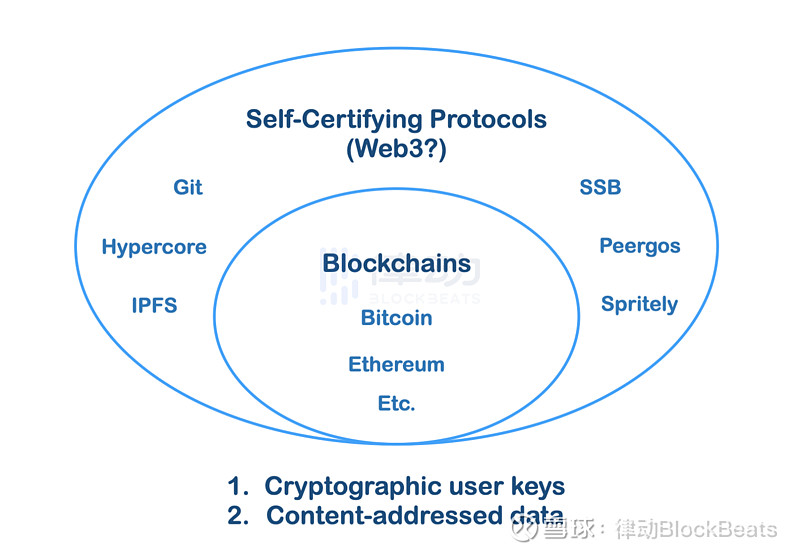Web3:一个自证协议的时代 谈到 Web3.0,大多人会想到区块链、token、元宇宙等等这些概念。毋庸置疑,Web3.0 包含了这一切,但我们该如...
资讯 2024-06-25 阅读:97 评论:0
谈到 Web3.0,大多人会想到区块链、token、元宇宙等等这些概念。毋庸置疑,Web3.0 包含了这一切,但我们该如何看清 Web3.0 的全貌呢?
talks about & nbsp; Web3.0, most people think about blocks chains, token, meta-cosm, and so on. Needless to say, Web3.0 contains all of this, but how do we see the full picture of & nbsp; Web3.0
首先,我们需要将 Web 和 3.0 拆开理解。Web,万维网(World Wide Web)的简称,一个负责识别网络资源的信息系统。3.0 代表次第三次迭代。
First, we need to open up & nbsp; Web and & nbsp; 3.0 understanding. Web, short for World Wide Web, an information system for identifying network resources. 3.0 representing the third overlap.
为什么需要迭代呢?因为现存版本存在问题。当人们发现 Web2.0 存在问题时,针对各类问题,会出现不同的解决方案。区块链,是众多解决 Web2.0 问题方案中的一种,所以区块链是 Web3.0 迭代的一部分。当 Web2.0 的问题被不同手段所解决时,我们就进入到了下一个网络时代,Web3.0。
Why should there be an overlap? Because there are problems with the existing versions. When people find problems & nbsp; Web2.0 there are problems, there are different solutions to problems. Block chains are one of many solutions Web2.0 so the block chain is Web3.0 part of the continuum. When & nbsp; Web2.0 problems are solved by different means, we enter the next web age, Web3.0..
本文出自著名线上社区 Bluesky 领头人 Jay Graber,文中对万维网的迭代进行简述并从自证协议角度介绍了 Web3.0。律动BlockBeats对全文进行了翻译:
This paper is from a well-known online community & nbsp; Bluesky Lead & nbsp; Jay Graber, which provides a brief overview of the World Wide Web and introduces & nbsp; Web3.0 from a self-initiated protocol. BlockBeats has translated the full text:

最近大家都在讨论究竟什么才是 Web3,而我对它的定义是:Web3 是由用户生成的权利,并通过自我认证的网络协议得以实现。这些协议不仅是一个包含区块链技术在内的技术超集,而且还远不限于此。其他人是这样看待「Web3」的吗?也许不是,但还请听我讲完。
Recently, everyone has been discussing what is & nbsp; Web3, which I define as: Web3 rights generated by users and realized through self-certified web protocols. These agreements are not only a technology superb that includes block chain technology, but are they much more than that. Does anyone else see "Web3" as such? Maybe not, but please listen to me.
网络上的权利决定了谁最终拥有对内容的控制权。在网络发展初期,「用户」与主机运营商之间并没有过多的区分,也就是说,网站的托管人往往也是网站内容的发布者。当网络发展到所谓的「Web 2.0」之后,各类网站开始变得流行起来,用户可以在上面开通账户并创建内容。但是在 Web 2.0 中,最终决定权依然掌握在网站主机手中,它们可以单方面地修改任何内容——这基本上也是目前网络的运作模式。在网络向 Web3 发展的过程中,用户可以通过 Crypto 手段来证明自己的身份,并发布可验证的内容,而其所在的网站也无权再去修改这些内容,因为信任根(root of trust)存在于数据本身当中,而不是它所处的地点。
The rights on the web determine who ultimately has control over the content. In the early days of network development, there is no too much difference between the “user” and the host operator, that is, the site's trustee is often the publisher of the content of the site. When the web is developed to the so-called “Web 2.0”, the web sites become popular, and users can open accounts and create content on them. But in Web 2.0 in & Web sites, the final decision power is still in the host of the site, and they can unilaterally modify any content - which is essentially the mode of operation of the network. In the process of development, users can prove their identity by means of Crypto, and they have no right to change it, because the root of trust is in the data itself, not where it is located.
让我们一起来回顾一下网络的整个发展脉络:
Let's look back at the entire development of the network:
Web 1.0——主机产出内容、主机生成权利。想在网络上发布内容的人必须使用自己的服务器来托管网站,而这类网站大多都是只读的,基本没有能让用户创建内容或参与互动的操作界面。
Web 1.0 - Host output content, host generation rights. Those who want to post content on the web must use their own servers to host websites, which are mostly read-only, with little interfaces that allow users to create content or participate in interactions. & nbsp;
Web 2.0——用户产出内容、主机生成权利。用户可以在网站上创建自己的个人账号,这样他们就不用为了在网络上发布内容而托管自己的服务器了。与此同时,越来越多由用户生成的交互式内容也因此而诞生。然而,这些网站逐渐发展为了功能强大的平台,它们对用户的账户和发布的内容依然具有绝对的控制权,而这也将引发许多问题。
Web 2.0 - User output content, host-generated rights. Users can create their own personal accounts on the website, so that they do not have to host their own servers to post content on the web. At the same time, an increasing number of interactive content generated by users is born. However, these sites have evolved as a powerful platform, and they still have absolute control over user accounts and published content, which will cause many problems; & nbsp;
Web 3.0——用户产出内容、用户生成权利。在新模式中,人们想要发布内容时不用再去托管服务器或在别人的数据库中创建账户。服务器虽然可以选择是否托管某人的账户或内容,但它们对其并没有最终权利。「自我认证协议」(self-certifying protocols)便能实现这一点,该技术是建立在 Crypto 签名和哈希值之上的一项技术。
Web 3.0 - User output content, user generation rights. In the new model, people want to publish content without having to go to the hosting server or create an account in another person's database. Servers, while they have the option of hosting a person's account or content, do not have the ultimate right to do so. Self-certification protocols, a technology based on Crypto signature and al-Hash.
简而言之,这三个阶段分别是「托管网络、发布网络以及签名网络」。
In short, the three phases are “host networks, distribution networks and signature networks”.
那么什么是「自我认证协议」呢?这是我用来描述具有 Crypto 用户标识符和内容编址数据协议的一个通用术语。其中「Crypto 用户标识符」可以将用户与公共密钥联系在一起,用户可以使用对应私钥进行签名,而这也是证明用户对其账户享有控制权的信任根,而不是用于记录用户登录情况的数据库条目。「内容编址数据」则意味着内容可以通过其 Crypto 哈希值来加以引用,而该值也是每条数据的唯一数字「指纹」。利用这两项技术,由用户密钥所签署的内容哈希便可以直接证明用户对该内容的授权,而不再需要中介机构出面证实了。能够进行自我认证的数据可以让信任留存于数据本身当中,而不是其所处地点,这让程序能够从客户服务器的架构中转移出来,并让「用户生成权利」成为了可能。
What is a "self-certification agreement"? This is a generic term that I use to describe data protocols with Crypto user identifiers and content compilations. The "Crypto user identifiers" can link the user to a public key, and the user can sign with the corresponding private key, which is proof that the user has control over its account, rather than a database entry for recording user login. The "content-in data" means that the content can be referenced through its Crypto Hashi value, which is also the only digital "print" for each data. Using these two techniques, the content signed by the user key, Harshi, can directly support the user's authorization of the content, without having to be confirmed by an intermediary. The data that can be self-certified can retain trust in the data itself, rather than its location, which allows the program to move from the structure of the client's server, and allows the "user to generate rights" to become possible.
如果说 Web3 是自我认证的协议,那么区块链在 Web3 中的作用又是什么?区块链是能够在全局状态上创建共识的自我认证协议,它可以在不受任何一方的控制的情况下模拟一个中心化的数据库。区块链上的「用户账户」是 Crypto 密钥对,用于签署交易,而「内容」则是捆绑在区块中的交易哈希值,这些区块本身也有自己的哈希,并被链接在了一起。Bitcoin(第一条区块链)引入了一种新的共识机制,让互不信任的各方可以在进行交易时达成一致——这对没有中介机构的数字货币来说至关重要。
If Web3 is a self-certification agreement, then what is the role of the block chain in Web3 ? The block chain is a self-certification agreement capable of creating consensus on a global scale, which can simulate a centralized database without control of either side. The "user account" on the block chain is Crypto key pairs are for signing the transaction, whereas the "content" is the Hashi value of the transaction tied to the block, which itself has its own Hashi and is linked together. Bitcoin (the first block chain) has introduced a new consensus mechanism that allows parties who do not trust to agree on the transaction - which is essential for digital money without an intermediary agency.
那有哪些协议是具有自我认证特性,但不属于区块链的呢?在 Bitcoin 之前出现的 Git、PGP、BitTorrent 和 Tahoe-LAFs 均属于这一类别。在现在这批非区块链自我认证协议中,IPFS、Hypercore、SSB、Pergos 和 Spritely 都具备用户密钥和内容编址功能。在这些协议当中,如果你可以证明某位用户「拥有」某条内容,那么你也就能顺势说明这名用户便是这条内容的发布者。区块链的出现进一步明确了所有权的概念,它建立了一个得到全球共识的时间戳账簿,全局有序和唯一性等属性在其中也得到了证实,这样一来,我们便能证明同一时间之内只有一人「持有」一枚 Bitcoin 或一件 NFT 作品。从架构上看,区块链可以被认为是 Web3 中的一类数据存储器,它可以对某些应用来说很实用,但对另一些应用来说却可能相当繁琐。从财政和社会的角度来看,区块链已经将注意力和资源转移到这个领域之中了。由区块链所建立起来的重要 Web3 基础设施,不仅包括能将密钥对发放到数百万用户手中的钱包及应用程序,也包括零知识证明这样为 Web3 带来无限可能的新型 Crypto 原语工具。虽然目前关于 Web3 的讨论热度已经超过了其他任何话题,但如果想实现 Web3 的全部愿景,我们还需要开发其他类型的自我认证协议。
In these now non-block chain self-certification agreements, which do not belong to the block chain? In Bitcoin pre-existing & nbsp; Git, PGP, BitTorrent and Tahoe-LAFs all belong to this category. In these agreements, IPFS, Hypercore, SSB, Pergos and & nbsp; Spritely has all the user keys and content-setting functions before. If you can prove that a user "has" a certain type of content, you can also describe that user is the publisher of this content; & spinn; & & nn; & spin; & neb; & neb, etc., it can also be used; & bb, it can be used; & bb, it can be used; & bn, it can be used; & n, it can be used; & b, it can be used; & b) it can be used.
如果一个自我认证协议可以让用户利用密钥和内容编址功能直接对内容作者的身份作出证明,那么一个自我认证的网络协议就也具备了内容链接和发现功能。我们如今使用的网络离不开内容发现算法的支持,不过 Web3 要想提升其用户体验,还需要进一步精化其算法功能。在我看来,以下是 Web3 中尚不存在或还未成熟的事物,包括社交图谱、用户档案、身份与信誉证明、内容聚合、索引与发现、以及策展和调控方法。不过令人感到困惑的一点是,目前应用于区块链技术的 Web3 依然是一盘散沙,少了很多我们期待在网络中看到的功能。
If a self-certification protocol allows the user to prove the identity of the content author directly by using the key and content site function, a self-accredited web protocol also has content links and discovery functions. The network we use today is supported by content discovery algorithms, but Web3 further refinement of its algorithm function is needed to enhance its user experience. In my view, the following are Web3 things that do not exist or are not mature, including social mapping, user files, identification and proof of credibility, integration of content, indexing and discovery, and methods of communication and regulation. But it is confusing that Web3 , which is currently applied to block chain technology, is still a dissipated piece of sand, and much less of what we expect to see on the web.
我希望在未来,Web3 能有一个更为宽泛的定义,从而被更多的人所认可,并将全部类型的自我认证协议都纳入其中,而所有的区块链都将只是 Web3 的一个分支。但是,与其关注这些术语,不如更多的去关注那些在互联网发展过程中起到重要作用的属性和特征。与此同时,我也希望未来的网络能把用户放在首位,让人们能自己掌握内容创作的决定权,无需再受限于任何中心化的服务。如果你同意我的看法,但出于某些原因不想使用「Web3」这一术语的话,那我们也可以将其称为「自我认证的网络协议」,简称 SCWP,该名称可以更为具体地概括这些新兴技术。
I hope that in the future, Web3 will have a broader definition that will be accepted by more people and incorporate all types of self-certification protocols, all of which will be a branch of Web3 but instead of focusing on these terms, it would be better to focus more on the attributes and characteristics that play an important role in the development of the Internet. At the same time, I hope that the future network will put users first, allowing people to have decision-making power over their own content creation, without being limited to any more central services. If you agree with me, but for some reason do not want to use the term "Web3", we could also call it a "self-certified network agreement", short & nbsp; SCWP, which can give a more specific overview of these emerging technologies.
注册有任何问题请添加 微信:MVIP619 拉你进入群

打开微信扫一扫
添加客服
进入交流群



















发表评论